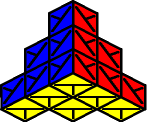

A Triamid has 4 corners and 6 edges. Even though each piece is identicle in shape, the corners have three different colors while the edges only have two. Because the Triamid is completely scrambled, a 3-colored piece could lie in "edge territory". A 3-colored piece could also lie in "corner territory", but with only two colors exposed. You may ask, "Where exactly does each corner piece have to go?" The answer might surprise you; it doesn't matter! As long as all of the 3-colored pieces are moved to the corners, you are on your way!
To spot a 3-colored-piece, pop the top and inspect the base. This will allow you to to view all four sides of each piece at the base.
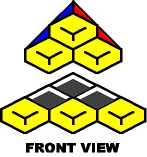
Once you find a 3-colored piece, snap the top back on, making a mental note of its location. (If you cannot find any 3-colored pieces, then rotate the Trimaid so that a different corner is on top, and pop the top again.)
If you are a beginner, then it is okay to cheat the first time around. In other words... go ahead and pop off a single piece, and snap it back on later, so that you can tell if it's a corner or edge piece.
If a 3-colored piece is located at an edge, then...
Rotate the entire Triamid so that...
 |
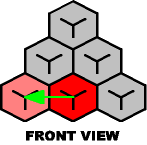 |
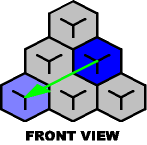 |
Lf- |
Lf+ |
Rf- Lf+ Rf+ |
All of the other "non-vacant" corners will remain intact. Once a 3-colored piece is at the corner, then it is time to...
In this case, only 2 colors are exposed, and two sides have matching colors. Rotate the entire Triamid so that...
 |
Lf- R+ T+ Lf- |
Repeat the first three steps (Find, Move & Show) for the remaining 3-colored pieces. You will not disturb the other corners in any way. However, you must place all 4 corner pieces before continuing on.
At this point, all 4 corners are in place. Look at any face of the Triamid. Each corner has 3 colors; however, only one color is common among the three corners of that face. Rotate each corner using "Pyraminx-type" moves (T+, T-, L+, L-, R+, R-, etc.) so that the common color is on the front side.
Look at the other sides of those three corners. Three possiblities exist:
 |
 |
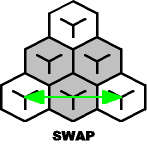 |
If no corners have matching sides, then the 2 bottom-front corners must be swapped. Hold the puzzle so that you are viewing the original front side.
Do the move... |
Rf- Lf- T+ |
...now at least 2 corners |
 |
 |
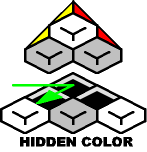 |
If only two corners have matching sides, then the oddball corner must be inverted.
Rotate the entire puzzle so that the oddball corner is at the lower-left (of the front side).
Pop the top to view the buried color of the oddball corner.
Snap the top back on, and rotate the entire puzzle so that...
Do the move... |
Lf- R+ T+ Lf- T- R- |
...now all three corners |
...Well, not exactly. You may have to apply a single Pyraminx-type move (either L+, L-, R+, R-, etc...) afterwards, to get the original front faces solid again. Now the 3 corners are solved.
At this point, 3 corners are solved. But wait a minute, there is a 4th corner of the Triamid! To solve the last corner, rotate the entire puzzle so that it is at the top, and use a "Pyraminx-type" move (either T+ or T-) until the front sides of the top and bottom corners match in color.
 |
 |
 |
Check the other two sides of the top corner. Only two possibilities exist:
Rotate the entire puzzle so that the last corner is at the lower-left (of the front side).
Pop the top to view the buried color of the last corner.
Snap the top back on, and rotate the entire puzzle so that...
Do the move... |
Lf- R+ T+ Lf- T- R- |
...now all four corners |
Once again, you may have to apply a single Pyraminx-type move (either L+, L-, R+, R-, etc...) afterwards, to get all 4 corners to match. Now the corners are solved.
NEXT: Place the Edges